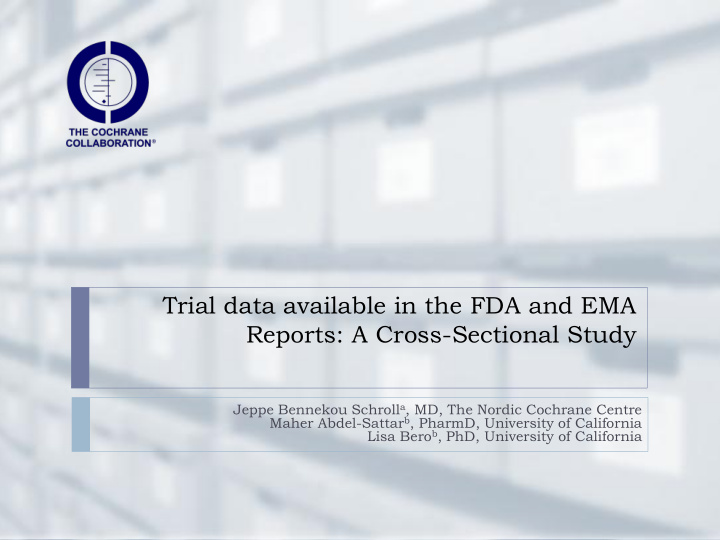



Trial data available in the FDA and EMA Reports: A Cross-Sectional Study Jeppe Bennekou Schroll a , MD, The Nordic Cochrane Centre Maher Abdel-Sattar b , PharmD, University of California Lisa Bero b , PhD, University of California
Background Regulatory data can alter meta-analysis (Hart2012) Regulatory data is only obtained in 3% of the Cochrane reviews that obtained unpublished data (Schroll2013) Lack of guidance on what agency to search Recent changes by drug agencies could make previous research outdated Hart B, Lundh A, Bero L. Effect of reporting bias on meta-analyses of drug trials: reanalysis of meta-analyses. BMJ 2012;344:d7202. Schroll JB, Bero L, Gøtzsche PC. Searching for unpublished data for Cochrane reviews: cross sectional study. BMJ 2013;346:f2231.
Background United states: Drug Approval Package Medical Review Statistical Review etc Europe: Assesment report European Public Assesment Report(EPAR)
Purpose To compare the accessibility, comprehensiveness and usefulness of data available from the European Medicines Agency (EMA) and Food and Drug Administration (FDA) drug reports.
Methods EMA and FDA websites searched for all new molecular entities that were approved by both agencies Data extraction from reports by two researchers Accessibility Comprehensiveness Usefulness for metanalysis (benefit and harms) Assessment of each agency Descriptive analysis
Characteristics of documents FDA EMA Average number of pages 1 (SD) 267 (158) 87 (27) Table of contents and searchable % (n) 70% (19) 100% (27) File partially redacted % (n) 100% (27) 0% (0) 3 Reasons for redaction indicated % (n) 96% (26) 100% (27) Lay summaries provided 0% 100% Communication between regulator and applicant 100% 0% Full trial reports /protocols available 0% 0%
Characteristics of trials and efficacy data FDA % (n) EMA % (n) Overview of trials with trial ID /trial name and summary 100% (27) 100% (27) ClinicalTrials.gov ID or corresponding 0% (0) 0% (0) Names of trial investigators and conflict of interest 0% (0) 0% (0) Trial methodology assessed (risk of bias domains) 19% (5) 0% (0) Patient population specified (inclusion, exclusion criteria) 96% (26) 96% (26) Intervention and comparison group specified 89% (24) 93% (25) Can the results be used in a meta-analysis? 100% (27) 96% (26 )
Harms FDA EMA Table of common adverse events 96% (26) 67% (18) All important harms reported 93% (25) 26% (7) Numerical results provided – safety 100% (27) 100% (27) Risk management plan / pharmacovigilance 48% (13) 100% (27) o further trials / studies required 78% (21) 48% (13)* o follow up existing trials 22% (6) 22% (6) o labeling restriction 4% (1) 100% (27) REMS / Educational material 30% (8) 26% (7)
Discussion Harms and efficacy data are available at the drug agencies Lack of accesibility and guidance can be the reason why data is rarely used The trials cannot easily be linked to publications Redaction of non-approved indications Only agency to sponsor communications available
Conclusion Both agencies provided data sufficient for meta-analysis FDA provided more data on harms EMA was more accessible and provided data on withdrawn or rejected drugs We recommend searching both agencies
Questions
Recommend
More recommend